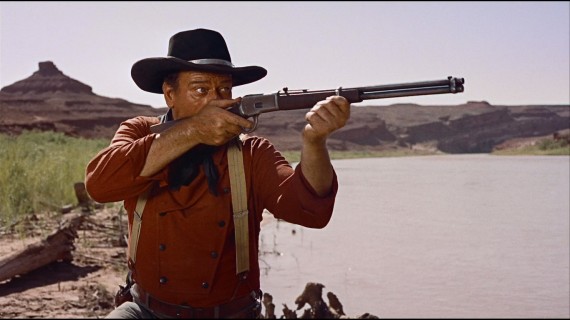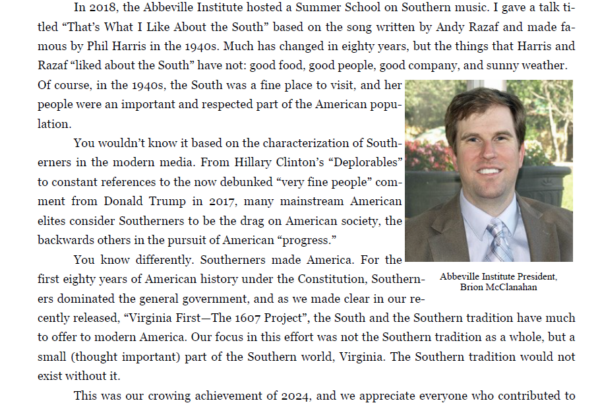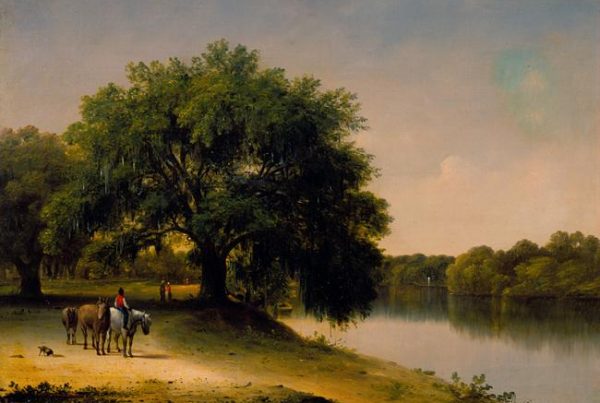
11. Post-bellum and Westerns
There are two interesting, important, and little noticed features of films about the South in the period after the War for Southern Independence. First, until recent times they generally portray the mainstream view of “Reconstruction” as corrupt and oppressive that prevailed before the Marxist coup in American history writing. Carpetbaggers are shown as vicious, greedy, and unprincipled, and Southerners as generally honourable people struggling against oppression. Hollywood was all on our side on the badness of Reconstruction. Indeed, that was the American consensus at the time. Even the impeccably Bostonian Samuel Eliot Morison of Harvard in his standard college history text deplored Reconstruction.
Second, such earlier films generally avoid most of the troubled Reconstruction South. Usually they are set in the western South—Texas, Indian Territory (Oklahoma), New Mexico, Arkansas, and Missouri. They often show sympathetic ex-Confederate people moving or returning West, which was indeed a major theme of Hollywood Westerns for a time. Such Reconstruction stories thus become in popular perception “Western” rather than Southern. This is conspicuously true of such classics as **The Searchers, **True Grit, and **Lonesome Dove, all stories of frontier Southerners.
“Western” is vague and elastic in the American imagination. American thought, writing, discussion, and cinema presentation of “the West” is confused and lacking in any clear idea of what the term should mean. Of course, Hollywood today usually means by “the West” the Rocky Mountains and Great Plains, the last settled regions. But the West actually began in 1607 just beyond the palisades of Jamestown in Tidewater Virginia and was a moving process for almost two centuries. The historian Frederick Jackson Turner, a Midwesterner, famously announced that the frontier ended in 1890—but he did not allow for the Texas and Oklahoma oil men who pioneered Alaska after that date.
Southerners were present everywhere during the great period of Western movement and were earliest and predominant everywhere except the Great Lakes and the Pacific coast. The American consciousness has put this truth down the memory hole: Western is assumed to be good and American (i.e., Northern) and Southern to be bad and un-American. This is done automatically and without reflection. The treatment of Texas provides a proving ground for this observation: if one likes Texas and wants to present it favourably, then it is “Western.” If one does not like Texas and wants to give it a bad rep then it is “Southern.” Of course, Texas is simply Texas, unimaginable except as a creation of Southerners and an extension of their homeland into new terrain.
Southerners acquired almost all the new territory of the U.S. after the Revolution, often against fierce Yankee opposition. They were also generally the earliest explorers and settlers of new territory. Daniel Boone moved west from North Carolina and Davy Crockett from Tennessee. Lewis and Clark were Virginians. Most of the men of the Alamo were Southern volunteers. The “mountain men,” who first explored the Rockies, like Jim Bridger and Kit Carson and Charles Bent of Bent’s Fort, were mostly from the South. In fact, the Cattle Kingdom began in the colonial South long before it reached Texas and merged with the Mexican version. And it was Texans who spread the Cattle Kingdom to the Northern plains, although Yankee and Brit capitalists swiftly moved in. (The late great Mel Bradford told me that there was a very large Confederate flag prominently displayed in the Cattlemen’s Club in Cheyenne. No telling if that is still so.)
The story of the West in general American thinking gets assumed into generic “America.” The multitude of watchers of the Daniel Boone and Davy Crockett television series in the 1950s never had any notion that this was Southern history. People are still shocked to learn that Boone’s and Crockett’s relatives were Confederates. Even though the people and settings are Southern, almost any time in film where Southern characters are sympathetic they are honourary Yankees. It is only the bad people who are obviously Southern.
Now there are some good films about the explorers and settles of the Northern plains and Rockies. **Jeremiah Johnson, **Heartland, and **O Pioneers! come immediately to mind. But “the West” was mostly Southern. The Philadelphia novelist Owen Wister understood this perfectly when he entitled his 1902 Wyoming novel The Virginian: A Horseman of the Plains. The Northern West is mostly about sodbusters, Yankee schoolmarms, snowstorms, and McCormick reapers. (The inventor Cyrus McCormick was from Virginia.)
Think about it. What is “a Virginian” doing in Wyoming? In fact, Wister was right on target. The cowboy, insofar as he is a heroic, chivalric figure and not merely a labourer in the hard and dirty business of moving livestock on the hoof, is a Southern gentleman moved to a new environment.
The schmaltzy Western movies and TV series of the 1950s and later perpetrated a cultural atrocity which would be eternally shameful were Americans any longer capable of experiencing shame: “the Singing Cowboy.” Several generations got their idea of the West from“Roy Rogers”(Leonard Slye from Iowa) singing “Happy Trails” in movies that were utterly anachronistic in their time and settings. Or from showbiz celebrities from the North pretending to be cowboys. Even the horses became stars. And there were the comic Westerns. The great and grim civilisational feat of the conquest and settlement of a continent, one of the most noble parts of American and world history, became juvenile commercial fluff imagined by Hollywood urbanites who had not a clue of genuine frontier history.
Remember that as you watch your “Westerns.”
The moguls were so ignorant of anything authentic that they almost always hopelessly misused the honourable terms “sheriff” and “marshal.” A sheriff is an elected official of a county, not a local officer who can be removed by the town. And a U.S. Marshal is an officer of a federal court with a wide jurisdiction, although there can be, I suppose, such a person as a Town Marshal.
**The Searchers (1956). The American Film Institute declares this the best Western of all time, and the British Film Institute lists it as the seventh best movie ever made. It is certainly a great film. It is set in the Texas frontier ravaged for several generations by war between Texans and the Comanche. (The U.S. Army had little to do with this war, neglecting the Texas frontier, especially during “Reconstruction.”) John Wayne, a former Confederate soldier, lives out a long and epic quest for his niece who was carried off as a child by the Comanche. There is a great deal of authentic flavour of the time and place. I must point out, however, that almost nobody talks like a Texan. The one character with an unmistakable Southern accent is a fool, a buffoon. This is unconscious Yankee prejudice. These are all Southern people, but in the Yankee mind they are Americans and “Westerners,” so a Southern accent is an automatic marker for something that is inferior. Remember, this is a Southern story.
**True Grit (1969). In what is perhaps his most beloved role, John Wayne is Marshal “Rooster” Cogburn, an ornery lawman on the border between Reconstruction Arkansas and the Indian Territory. Based on a novel by the Arkansas writer Charles Portis, True Grit, like most “Westerns,” is really a “Southern” story. A feisty young woman enlists Cogburn’s reluctant aid for a mission into Indian Territory. The film is deservedly popular and often considered John Wayne’s best. The remake, (X)True Grit (2010), though widely praised, is much inferior. Everybody in it acts and talks like they come from California and have not a clue about the people they are impersonating. The young woman’s Christianity disappears completely. A Smithsonian production called (X) “The Real True Grit” epitomises the confusion of West and South. The “experts” speculate about whether a brave and adventurous girl like Mattie Ross could have really existed, and then get into discussions about “Calamity Jane” and such stuff. Mattie Ross was not a frontier moll, she was a Southern lady.
**Rooster Cogburn (1975). In this enjoyable sequel Rooster (John Wayne) tangles with the Yankee schoolmarm Katherine Hepburn.
**Hondo (1953). It is implied that Hondo (John Wayne) is an ex-Confederate.
**Hondo and the Apaches (1967). Pretty good film based on the TV series with the Hondo character.
(T) Texas (1941). Ex-Confederates Glenn Ford and William Holden go to Texas.
(T) Texas Rangers (1951) is pretty good on context although not in the plot.
**The Rebel (TV series, 1959—1961. Ex-Confederate roams the west doing good deeds.
**Lonesome Dove (1989-90) is of course about the Southern frontier and the expansion of the Texas cattle kingdom, although the scalawag author of the novel on which it is based plays down the Southern element. Yet the movie and its prequels and sequels (**Return to Lonesome Dove, **Streets of Laredo, and **Dead Man’s Walk are inescapably Southern. Some of the actors, like Tommy Lee Jones, Robert Duvall, Sissy Spacek, and James Garner act like real Southern people. Dead Man’s Walk is actually set in the antebellum period.
**Comanche Moon (2008). This Lonesome Dove prequel is actually set in the Confederate period and does not disguise the fact.
**Red River (1948) and **Chisum (1970). John Wayne “westerns” that present the heroic early pioneers of Texas through antebellum, Confederate, and post-bellum years, although they do not make a point of it. In Red River Montgomery Clift leaves the ranch to join the Confederate army.
(T) Belle Starr: Bandit Queen (1941). Weak on history but entertaining and good on “Reconstruction.” Randolph Scott at his best. The accents are good, although Gene Tierney tends to overdo it, and there is great “Dixie” background music. (X) Belle Starr (1980) may be a little closer to history but is slow and boring.
**Geronimo: An American Legend (1993). Dramatisation of the true story of Charles Gatewood, a lietenant in the postbellum U.S. Army who came from a Virginia Confederate family. Gatewood worked hard to understand the Apaches and a great risk to himself brought Geronimo in with a peace agreement. The dishonourable, ethnic-cleansing Yankee government then repudiated what they had agreed to and shunted Gatewood into obscurity. Jason Patric, though a New Yorker, does one of the most faithful Southern accents in recent times.
**The Missing and **Open Range (both 2003). Excellent truthful stories of hardship, danger, and courage on the rugged Southwestern frontier.
**The Long Ride Home (2003). Randy Travis trying to get home to his family after years of dodging the law and the lawless.
**Reckoning (?). This toughly realistic Southwestern seems to have fallen through the cracks and I can find little information. (It is not to be confused with a 2018 Western or any other films of the same title.) The main actors seem to be relatively unknown Southerners and all of the good guys have authentic accents. And for once the chief villain definitely does not speak Southern.
Nearly every major Hollywood star of the 1930s—1960s at some time played a sympathetic Confederate character, often in the Reconstruction era. Something sure to send today’s guardians of culture into frantic pearl-clutching. A few examples:
**The Proud Rebel (1958). Alan Ladd is an ex-Confederate travelling to Illinois and Minnesota in search of a cure for his traumatised son. Northerners give him a hard time but he triumphs in the end. (And I have to mention Alan Ladd in **Shane when he tells the gunman “Your’e a lowdown Yankee liar,” before finishing him off.)
**Escort West (1958). Victor Mature is a widowed ex-Confederate soldier heading West with his young daughter in search of a new life. A brave and honourable man, he comes to the aid of two Northern women in peril from Indians.
**Dallas (1950). Gary Cooper is a Confederate hero from Georgia fighting very nasty Carpetbaggers in Texas who are not only oppressing Southerners but Mexicans as well. Meeting a decent Northerner he comments: “That Yankee furriner is talking like an American.” The star does pretty well on the accent most of the time. Cooper plays another ex-Confederate in (T) Vera Cruz.
**Three Violent People (1956). Charlton Heston returns home to fight carpetbaggers who want to seize his land.
Four Southern stars with a similar ex-Confederate theme:
**El Paso (1949). Ex-Confederate John Payne cleans up corruption
**The Vanquished (1953). Confederate John Payne returns to his Texas home and successfully counters the Carpetbaggers.
**The Stranger Wore a Gun (1953). Tough ex-Confederate Randolph Scott fights bad men in Arizona. Based on the novel Yankee Gold. Not to be confused with the unrelated Stranger with a Gun (1958).
**Hell on Wheels (TV, 2011—2016). A recent surprising revival of the good Confederate moving West genre. Anson Mount, a native Southerner, is the hero in this complex and tough drama of railroad building in the West.
A few non-Western Reconstruction films:
(T) Tennessee Johnson (1942). Andrew Johnson is portrayed as a hero by Van Heflin. This is hard to find but is worthwhile for its portrayal of President Johnson struggle against the evil Radical Republicans.
**Menace on the Mountain (1970). Southern families fighting against corruption and violence in North Carolina right after The War.
**The Keeping Room (2014). Bleak but telling story of Southern women suffering Yankee depredations as the war ends.
____________________________________________________________
JESSE JAMES
The exploits of Frank and Jesse James (along with the Younger brothers) have fueled a library of movies and TV shows, far more than it is possible to survey here. Many of them are just mediocre “Westerns.” A few understand that the James boys came to their path as outlaws because they were victims of “Reconstruction” oppression.
(T) Jesse James (1939) and (T) The Return of Frank James (1940), with the major stars Henry Fonda and Tyrone Power, are old standbys, not very strong on Southern but telling the story well enough.
**Frank and Jesse (1994), which includes Randy Travis as Cole Younger, comes closest to representing the real history and is the truest to life James movie in my opinion.
** The Long Riders (1980), about the failed James and Younger raid in Minnesota. Arthur Hill, a good director, gives the last period of the James-Younger gang an appropriate epic treatment. The atmosphere and accents are good. (X) The Great Northfield Minnesota Raid (1972), on the same subject in worthless and seems to have no purpose other than to degrade the characters.
Most of the other films on the subject are hardly worth your notice. (X) The Lawless Breed with “Rock Hudson” as Jesse James and the silly (X) The Assassination of Jesse James by the Coward Robert Ford may be safely ignored.
WHAT COULD BE: The stories of any one of the most conspicuous carpetbaggers—Adelbert Ames, Henry Clay Warmouth, etc., would make entertaining and informative flicks. Many carpetbaggers were extravagant characters blatantly and joyfully corrupt. Their careers would be a good way to tell the truth about “Reconstruction.” The Texas Rangers appear in many mediocre Westerns, few of which touch the real story. What marvelous films could be made of the Rangers in their greatest period after The War and their heroes like John C. Hays, “Rip” Ford, and L.H. McNelly. But such stories would be unkind to noble and oppressed Mexicans and Redskins.
More Southern Westerns set in later times appear in subsequent chapters.






